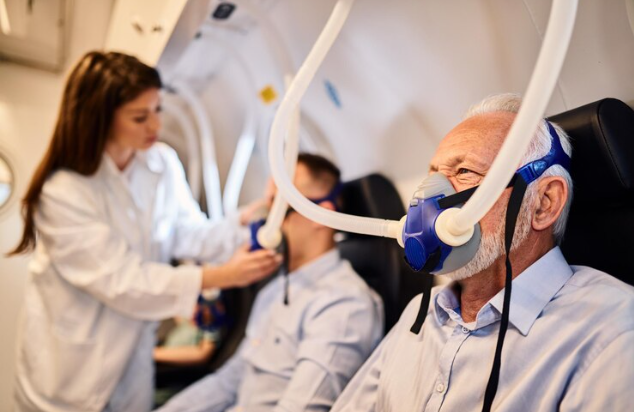Key Takeaways:
- Hyperbaric oxygen therapy (HBOT) can assist in the healing of various health conditions.
- HBOT works by increasing oxygen levels in the blood, promoting faster recovery.
- Conditions like chronic wounds, infections, and even neurological issues can benefit from HBOT.
- Scientific studies support the effectiveness of HBOT in various medical treatments.
Table of Contents
- What Is Hyperbaric Oxygen Therapy?
- How HBOT Works
- Benefits of HBOT
- Conditions Treated by HBOT
- Scientific Support for HBOT
- Real-Life Case Studies
- How To Access HBOT
- Conclusion
What Is Hyperbaric Oxygen Therapy?
HBOT is a medical procedure where patients inhale pure oxygen in a pressurized environment. This procedure boosts the body’s innate ability to heal by elevating the oxygen levels in the bloodstream. This process enhances the body’s natural healing powers by increasing the oxygen levels in the blood. While HBOT has been used for decades, its applications continually expand, making it a hot topic in modern medicine. Interestingly, HBOT can be part of oxygen therapy regimens that address intricate health conditions. Patients undergoing HBOT sit or lie in a specialized chamber where they breathe oxygen at higher-than-normal atmospheric pressures.
The therapy capitalizes on the principle that increasing atmospheric pressure dissolves more oxygen in the blood plasma. This allows enhanced oxygen delivery to tissues that are otherwise challenging to reach under natural conditions. The increased oxygenation speeds up various healing processes and helps the body fight certain infections more effectively.
How HBOT Works
The principle behind HBOT is to elevate the amount of oxygen your blood can carry. Under normal atmospheric conditions, oxygen enters the body and is transported throughout the bloodstream. Inside a hyperbaric chamber, the air pressure is boosted to three times the usual level, enabling the lungs to intake more oxygen compared to breathing pure oxygen at regular air pressure. This high oxygen concentration helps promote rapid healing by reducing inflammation and aiding in the body’s natural defense mechanisms.
HBOT works at a cellular level, enabling cells to function more efficiently. It stimulates angiogenesis (the formation of new blood vessels) and supports neurogenesis (the creation of new neurons), vital for repairing damaged tissues. It also bolsters the immune system by promoting the activity of white blood cells, which is essential for fighting infections and managing inflammation.
Benefits of HBOT
One of the main advantages of HBOT is that it can activate the production of chemicals known as growth factors and stem cells, which aid in the healing process. Besides, increased oxygenation can decrease swelling and inflammation, assisting in faster recovery from injuries. The therapy has been instrumental in treating complex wounds and enhancing the overall recovery of patients suffering from various conditions.
- Promotes the healing of chronic wounds—Conditions such as diabetic foot ulcers, pressure ulcers, and venous stasis ulcers benefit significantly from increased oxygen levels.
- Reduces the severity of infections—Enhanced oxygenation can disable certain bacteria and boost the efficiency of antibiotics, assisting in treating diseases like necrotizing soft tissue infections.
- Supports recovery from neurological conditions—Patients with traumatic brain injuries, strokes, and neurodegenerative diseases have shown improvements in cognitive and functional capabilities after undergoing HBOT.
Another noteworthy benefit of HBOT is its potential to mitigate the side effects of cancer treatments like radiation therapy. Radiation can damage healthy tissues and result in side effects such as radiation-induced wounds and tissue necrosis. HBOT helps regenerate these tissues, providing relief to cancer patients.
Conditions Treated by HBOT
HBOT is known to be an effective treatment for a variety of conditions. For example, the therapy is used to heal chronic wounds like diabetic foot ulcers. It can also assist in the recovery from infections such as necrotizing fasciitis and osteomyelitis. Beyond wound care, HBOT is gaining traction in diverse medical fields for its ability to treat the underlying causes of various disorders.
In the realm of neurological health, HBOT has shown promise for conditions like stroke, traumatic brain injury, and even autism spectrum disorders. While ongoing research continues to explore these benefits, early results are encouraging. Conditions like fibromyalgia, Lyme disease, and even post-traumatic stress disorder (PTSD) have seen positive advancements with supplementary HBOT sessions.
Moreover, sports medicine has also adopted HBOT to treat severe injuries and aid in faster recovery. Athletes suffering from ligament tears, muscle strains, and fractures can experience accelerated healing and return to their sports activities more swiftly.
Scientific Support for HBOT
Scientific studies have provided substantial evidence supporting HBOT’s effectiveness. Research published in authoritative medical journals has shown HBOT’s benefits in treating various conditions, including chronic wounds and radiation injuries. Another significant study discussed its positive impacts on neurological rehabilitation.
Studies have indicated that HBOT can significantly improve the quality of life for patients suffering from non-healing wounds and complicated infections. In neurology, research reveals that HBOT can enhance neuroplasticity, the brain’s ability to reorganize itself, which is crucial for recovery post-stroke or brain injury. These findings are pivotal in creating new treatment methodologies incorporating HBOT into their spectrum.
Real-Life Case Studies
Several case studies illustrate the real-world applications of HBOT. For instance, a middle-aged woman suffering from diabetic foot ulcers was able to avoid amputation and achieve full recovery after several HBOT sessions. Another example involves a young athlete who recovered significantly faster from a severe ankle injury, enabling a return to competitive sports. These case studies highlight the practical benefits and transformative potential of HBOT.
In another compelling example, a veteran suffering from PTSD experienced notable improvements in mental clarity and emotional stability after undergoing HBOT. These anecdotal accounts provide valuable insights into how HBOT can be employed effectively across different medical scenarios, from chronic conditions to acute injuries.
How To Access HBOT
Accessing Hyperbaric Oxygen Therapy is increasingly becoming more accessible. Most large hospitals and specialized clinics offer this treatment. To ascertain if HBOT is right for you, it’s crucial to consult with a healthcare provider who can provide guidance based on medical history and the specific condition being treated. As technology progresses, portable hyperbaric chambers are also becoming available for home use, offering greater flexibility.
- Consult with a healthcare provider—A thorough medical evaluation is essential to determine the suitability of HBOT for your condition.
- Ensure the facility meets medical standards—Always opt for accredited facilities that adhere to rigorous safety and operational protocols.
- Understand the treatment protocol and duration—HBOT sessions typically range from 60 to 120 minutes, depending on the condition being treated, and an entire treatment course may require several sessions over weeks or months.
Conclusion
Hyperbaric oxygen therapy is a promising medical treatment with a variety of applications. From chronic wound healing to supporting neurological health, HBOT offers numerous benefits backed by scientific research. As healthcare providers continue recognizing its potential, HBOT may become a standard treatment for many health conditions. This evolving medical technology stands as a testament to the wonders of oxygen in healing and improving human health.
Keep an eye for more news & updates onDiscoverTribune.Org!




